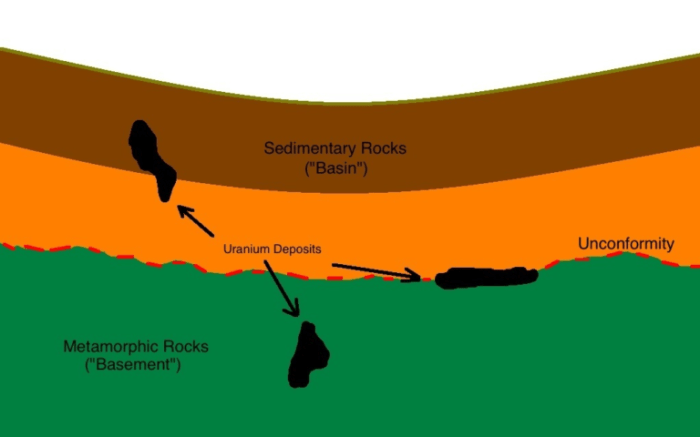All deposits of natural uranium contain appreciable amounts of the element. This is due to the fact that uranium is a naturally occurring element that is found in the Earth’s crust. Uranium is a radioactive element, and it is the heaviest naturally occurring element.
It is a metal that is silvery-white in color, and it is malleable and ductile. Uranium is used in nuclear power plants to generate electricity.
The amount of uranium in a deposit can vary depending on the type of deposit. For example, uranium deposits that are found in sedimentary rocks typically contain less uranium than uranium deposits that are found in igneous rocks. The amount of uranium in a deposit can also vary depending on the location of the deposit.
For example, uranium deposits that are found in areas with high levels of radioactivity typically contain more uranium than uranium deposits that are found in areas with low levels of radioactivity.
Definition of Natural Uranium and its Composition

Natural uranium is a naturally occurring radioactive element found in the Earth’s crust. It is composed primarily of two isotopes: uranium-238 ( 238U) and uranium-235 ( 235U). 238U constitutes approximately 99.3% of natural uranium, while 235U accounts for the remaining 0.7%. These isotopes have different half-lives and decay characteristics, influencing the overall properties and applications of natural uranium.
Distribution of Natural Uranium Deposits
Natural uranium deposits are found in various geological formations worldwide. The most significant uranium-producing regions include the Athabasca Basin in Canada, the Karoo Basin in South Africa, and the McArthur River-Ranger region in Australia. These deposits are typically associated with sedimentary rocks, sandstone, and volcanic rocks formed under specific geological conditions favorable for uranium accumulation.
Types of Natural Uranium Deposits

Natural uranium deposits can be classified into several types based on their geological setting and mineralogy:
- Unconformity-related deposits:These deposits occur at the interface between sedimentary rocks and underlying basement rocks. Uranium is concentrated at the contact zone due to the interaction of groundwater with the basement rocks.
- Sandstone deposits:These deposits are found in sandstone formations and are characterized by the presence of uranium minerals dispersed throughout the sandstone matrix.
- Vein deposits:These deposits occur in fractures or veins within rocks. Uranium minerals are deposited by hydrothermal fluids circulating through the fractures.
Appreciable Amounts of Natural Uranium

An “appreciable amount” of natural uranium in the context of deposits refers to concentrations that are economically viable for mining and extraction. The minimum cutoff grade for uranium deposits varies depending on the mining method and processing technology used. Typically, deposits with uranium concentrations above 0.05% U 3O 8(uranium oxide) are considered economically exploitable.
Extraction and Processing of Natural Uranium
Extracting uranium from natural deposits involves several steps:
- Mining:Uranium ores are mined using open-pit or underground mining methods.
- Milling:The mined ores are crushed and ground to liberate the uranium minerals.
- Leaching:The ground ore is treated with a leaching solution to dissolve the uranium minerals.
- Ion exchange:The uranium-bearing solution is passed through ion exchange resins to separate the uranium from impurities.
- Precipitation:The uranium is precipitated from the ion exchange solution as a solid compound, typically uranium oxide (U 3O 8).
Applications of Natural Uranium: All Deposits Of Natural Uranium Contain Appreciable Amounts Of
Natural uranium has various applications, primarily in the following areas:
- Nuclear power generation:Natural uranium is used as fuel in nuclear reactors to produce electricity.
- Medical imaging:Depleted uranium (a byproduct of uranium enrichment) is used as a shielding material in medical imaging equipment.
- Industrial applications:Uranium compounds are used in ceramics, glass, and pigments.
Expert Answers
What is uranium?
Uranium is a naturally occurring element that is found in the Earth’s crust. It is a radioactive element, and it is the heaviest naturally occurring element. It is a metal that is silvery-white in color, and it is malleable and ductile.
Uranium is used in nuclear power plants to generate electricity.
What are the different types of uranium deposits?
There are two main types of uranium deposits: sedimentary deposits and igneous deposits. Sedimentary deposits are formed when uranium is deposited in layers of sediment. Igneous deposits are formed when uranium is deposited in molten rock.
Where are uranium deposits found?
Uranium deposits are found all over the world. The largest uranium deposits are found in Australia, Canada, Kazakhstan, Namibia, and the United States.